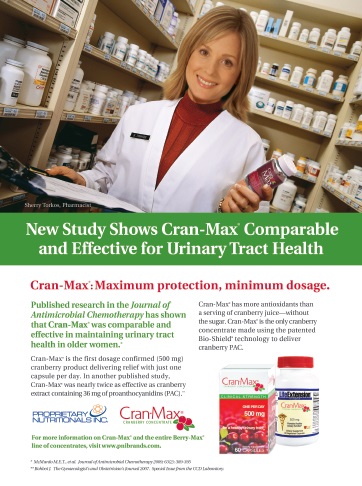Find the ingredients list on a box of tampons or pads. If one is not displayed or if the list contains synthetic ingredients, tell shoppers to take caution. Some of these ingredients may do more harm than good to a woman’s body and the environment.
How Can Feminine Products Be Harmful?
The skin is the largest organ in the body, and it is also the thinnest. Less than one-tenth of an inch separates the body from potential toxins (1). Skin is also highly permeable—especially around the vaginal area, not to mention inside the vagina itself, which is lined with mucous membranes that can easily absorb and be irritated by chemicals (1). Once a substance is absorbed through the vaginal wall, it will head directly into the bloodstream, bypassing any filtering that occurs when substances are ingested by mouth (1).
What Is in Those Tampons?
Most tampons contain only a small percentage of cotton, and the majority of it is made out of materials such as rayon (made from cellulose fibers derived from bleached wood pulp), viscose (a form of wood cellulose acetate that’s fabricated to have a cotton-like touch) and fluff pulp (manufactured from tree wood and the major filler used in conventional sanitary pads) (1).
What’s highly concerning about these fibers is what happens when tampons absorb fluid and expand. Fibers can detach and stick to the vaginal walls. And when a tampon is removed, the fibers can be left behind or even scrape and peel off a layer of the vaginal lining, creating a favorable environment for bacterial growth and discomfort (1).
What’s the Harm with These Ingredients?
There’s more to be worried about. For tampons and pads to look clean and white, the fibers must be bleached. When bleaching with chlorine, toxic dioxin and other by-products are created. Studies by the Department of Health (DOH) have shown that dioxin collects in fatty tissues and may be linked to cancer, reproductive issues or developmental problems.
In response to consumers’ concerns over dioxins, the U.S. Food and Drug Administration (FDA) released a patient alert stating tampons are now produced using totally chlorine-free bleach (which may use hydrogen peroxide as the bleaching method) or elemental chlorine-free bleach (which uses methods like chlorine dioxide to bleach).
According to the alert, elemental chlorine-free bleaching is considered a dioxin-free method, but can “theoretically” generate dioxins at extremely low levels. In addition, the draft stated that the trace amounts of dioxin found in tampons are considered safe and are present due to mill effluents and decades of environmental pollutants (2). However, according to the U.S. Environmental Protection Agency (EPA), there are no established safe levels of exposure to dioxins, which can accumulate and stay in the body for 30 years. The EPA also reported that repeated contact increases health dangers.
Even tampon applicators bear a potential risk to a consumer’s health. The shiny finish along the plastic  tube comes from phthalates, which are chemical plasticizers in polyvinyl chloride products. When phthalates are added to plastic, they increase the flexibility and durability of that plastic and allow the product to last longer (3). Phthalates have been nicknamed “the everywhere chemical” and can be found in thousands of products including children’s toys, perfumes and nail polish, and have been linked to the interference of the hormone system (3).
tube comes from phthalates, which are chemical plasticizers in polyvinyl chloride products. When phthalates are added to plastic, they increase the flexibility and durability of that plastic and allow the product to last longer (3). Phthalates have been nicknamed “the everywhere chemical” and can be found in thousands of products including children’s toys, perfumes and nail polish, and have been linked to the interference of the hormone system (3).
Certain applicators also pose a risk to the environment. Plastic is made from petro-chemicals that are derived from ethane, propane, butane and other hydrocarbons extracted from crude oil and natural gas liquids (4). During the process of extracting, producing and manufacturing plastic, large amounts of toxic pollution, such as nitrogen oxide, sulphur dioxide and carbon dioxide, are released into the environment and contribute to global warming, the acidification of trees and negative health effects (5). When consumers throw away plastic applicators, they end up in landfills or are incinerated. When plastic applicators are incinerated, over 90 different chemicals, like BPA, dioxin and chloride are released (6).
What’s highly concerning are when marine wildlife, like plankton eat microscopic fragments of plastic that have ended up in their habitats, which could then be passed up the food chain (7).
What Is in Those Lubricants?
When experiencing vaginal dryness, the use of a lubricant can help reduce friction and increase comfort. However, consumers may be surprised to learn that many synthetic lubricants contain chemicals that were first designed for use on automobiles and even in oven cleaners (8). Shoppers may want to avoid these ingredients:
• Parabens: Parabens can interfere with estrogen, which can fuel cancer growth in some people (9).
• Acetate: Acetate is a form of alcohol that can dry out the skin and cause tearing, which can open consumers up to infections (9).
• Petroleum: Petroleum can coat the skin, impeding its normal functions and making condoms less effective due to dislodgment (9).
• Phenoxyethanol: When phenoxyethanol breaks down in the body, it begins to release phenol, which can adversely affect the immune system (8).
• Propylene glycol: Propylene glycol is also used as a solvent, classed with acetone and chloroform, which may cause burning or tissue irritation in some women (8).
• Chlorhexidine: Chlorhexidine is an ingredient in some multipurpose lubricants that can be an irritant (8).
In a recent study presented at the International Microbicides Conference, biophysicists suggested that some vaginal lubricants increased the risk of catching diseases such as chlamydia and gonorrhea. The study found that lubricants that were hyperosmolar can cause cells in rectal and vaginal tissue to shrivel up and come off, thus weakening the body’s defenses. Many personal lubricants are deemed hyperosmolar, due to the fact that they contain large amounts of ingredients such as glycerin and propylene glycol (10). The study results also showed women who used hyperosmolar lubricants are more likely to contract bacterial vaginosis (BV), an infection caused when too much of a certain bacteria changes the normal balance of bacteria in the vagina (11).
While cause and effect have not been proven, these study results may certainly compel some shoppers to buy only natural lubricants.
Safer Alternatives
Tampons. In the United States alone, over 85 million women are of menstruating age, which can add up to a lot of waste. Approximately 13,440 menstrual napkins are used in one lifetime (12). And according to the National Women’s Health Network, women contribute a combined 12 billion pads and seven million tampons to landfills each year.
Unlike conventional pads and tampons made from materials that are not biodegradable, all-cotton products are capable of being decomposed by bacteria or other living organisms, which can help fight  the burden being placed on landfills.
the burden being placed on landfills.
By choosing natural cotton, consumers are also picking feminine products that are unbleached or whitened with hydrogen peroxide (1). When using hydrogen peroxide, there is no risk of dioxin being released into the environment and into one’s system. Many natural/organic cotton tampon makers also choose cardboard applicators that are bio-degradable, eliminating consumers’ exposure to phthalates.
Some manufacturers also weave the cotton in such a way to eliminate fragment shedding. Independent research conducted at New York University Medical School, even suggested that 100% cotton tampons may reduce a women’s risk of contracting toxic shock syndrome, a rare but dangerous bacterial infection linked to prolonged tampon use.
Of course, natural cotton can potentially contain pesticides. If a chemical-free feminine care product is a high priority, then a brand made with 100% organic cotton is the best bet, since organic cotton must meet strict federal regulations regarding how cotton is grown, including the type of seeds used.
Pads. Many women turn to reusable pads due to the airflow that helps reduce irritation and eliminate odor (13). It also happens to be quite affordable since they can last for up to five years. Like conventional pads, cloth pads come with options such as wings that snap around one’s underwear and come in different sizes and absorbencies. Reusable pads must be changed often, as one would change a disposable pad, and be cleaned by hand or washer.
Menstrual cups. These flexible cups collect menstrual flow rather than absorbing it like tampons or pads. They are typically made out of silicone or rubber and also come as a disposable option, which must be thrown away after a single use. When using a typical tampon or pad, it must be replaced every four to eight hours, but the cup can last for six to 12 hours before it needs to be emptied (14). Women who choose a menstrual cup won’t have to worry about menstrual odors, since the fluid doesn’t get exposed to air as it does with pads and tampons (15). However, like most items that must be inserted, individual anatomy can make proper use of the cup difficult. For instance, if consumers have fibroids or a dropped uterus, the cup may not fit in place properly. And if using an IUD, a menstrual cup could pull the IUD strings and dislodge it (14).
Sea sponge. This tampon alternative is biodegradable and comes in different sizes for varying absorption amounts of menstrual flow (15). They are harvested from the ocean floor, bleached with hydrogen peroxide and last for about six months. Unlike tampons, a sea sponge must be rinsed out every three hours and dried properly before reuse. Sea sponges can also tear while inserting and removing them from the vagina.
Lubricants. Water-based lubricants carry water to the vagina’s mucous membranes to protect them and to release moisture for sustained hydration (16). Sample ingredients in water-based lubricants include vitamin E and aloe, which offer moisture and comfort (17).
Why Should Consumers Care?
The vaginal area is highly sensitive and important to women’s health. With the high demand for healthy and eco-friendly products, it is time to start addressing natural feminine health needs and become aware of the dangers that lurk in mainstream care products. WF
References:
1. Dr. Mercola, “Women Beware: Most Feminine Hygiene Products Contain Toxic Ingredients,” May 22, 2013, http://articles.mercola.com/sites/articles/archive/2013/05/22/feminine-hygiene-products.aspx, accessed Dec. 21, 2015.
2. U.S. Food and Drug Administration, “Tampons and Asbestos, Dioxin, & Toxin Shock Syndrome,” May 13, 2015, www.fda.gov/MedicalDevices/Safety/AlertsandNotices/PatientAlerts/ucm070003.htm, accessed Dec. 21, 2015
3. National Institute of Environmental Health Sciences, “Phthalates the Everywhere Chemical,” www.niehs.nih.gov/research/supported/assets/docs/j_q/phthalates_the_everywhere_chemical_handout_508.pdf, accessed Dec. 21, 2015.
4. American Fuel & Petrochemical Manufacturers, “Petrochemicals,” www.afpm.org/petrochemicals, accessed Dec. 21, 2015.
5. Natracare, “Plastic Free,” www.natracare.com/why-natracare/plastic-free, accessed Dec. 21, 2015.
6. World Centric, “Pollution and Toxins: General,” http://worldcentric.org/about-compostables/traditional-plastic/pollution, accessed Dec. 21, 2015.
7. “Plankton Snacking on Plastic caught on Camera for the First Time,” New Scientist, July 6, 2015, www.newscientist.com/article/dn27849-plankton-snacking-on-plastic-caught-on-camera-for-the-first-time, accessed Dec. 21, 2015.
8. L. Steelmith, “Sexual Lubricant: 7 Ingredients to Avoid,” Care2, www.care2.com/greenliving/sexual-lubricant-7-ingredients-to-avoid.html, Oct. 13, 2012, accessed Dec. 21, 2015.
9. Condom-Sizes. “Best Lubricant Against Yeast Infection,” www.condom-sizes.org/sexual-health/best-lubricants-yeast-infection, accessed Dec. 21, 2015.
10. L.Wolf. “Studies Raise Questions about Safety of Personal Lubricants,” Chemical & Engineering News, Dec. 10, 2012, http://cen.acs.org/articles/90/i50/Studies-Raise-Questions-Safety-Personal.html, accessed Dec. 21, 2015.
11. Centers for Disease Control and Prevention, “Bacterial Vaginosis—CDC Fact Sheet,” www.cdc.gov/std/bv/stdfact-bacterial-vaginosis.htm, accessed Dec. 21, 2015.
12. U.S. Census Bureau, “Quick Facts,” http://quickfacts.census.gov/qfd/states/00000.html, accessed Dec. 21, 2015.
13. The Willow Store, http://thewillowstore.com/shop/regular-organic-feminine-pads, accessed Dec. 21, 2015.
14. E. Ross, “Tired of Tampons? Here are Pros and Cons of Menstrual Cups,” Feb. 9, 2015, http://health.clevelandclinic.org/2015/02/tired-of-tampons-here-are-pros-and-cons-of-menstrual-cups, accessed Dec. 21, 2015.
15. Center for Young Women’s Health, “Period Products: Information about tampons, pads and more,” http://youngwomenshealth.org/2013/03/28/period-products, accessed Dec. 21, 2015.
16. Organic Lifestyles, “Yes Organic Lubricant—FAQs,” https://organiclifestyle.com/articles/yes-organic-lubricant-faqs, accessed Dec. 21, 2015.
17. T. Bernard, “The Ins and Outs of Eco-Friendly Vaginal Lubrication,” Green Prophet, June 1, 2010, www.greenprophet.com/2010/06/sex-eco-friendly-vaginal-lubrication, accessed Dec. 21, 2015.
Published in WholeFoods Magazine February 2016









